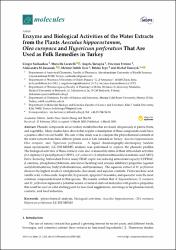| dc.contributor.author | Sarıkürkçü, Cengiz | |
| dc.contributor.author | Locatelli, Marcello | |
| dc.contributor.author | Tartaglia, Angela | |
| dc.contributor.author | Ferrone, Vincenzo | |
| dc.contributor.author | Juszczak, Aleksandra M. | |
| dc.contributor.author | Özer, Mehmet Sabih | |
| dc.contributor.author | Tepe, Bektaş | |
| dc.contributor.author | Tomczyk, Michał | |
| dc.date.accessioned | 2021-05-05T22:11:51Z | |
| dc.date.available | 2021-05-05T22:11:51Z | |
| dc.date.issued | 2020 | |
| dc.identifier.issn | 1420-3049 | |
| dc.identifier.uri | https://doi.org/10.3390/molecules25051202 | |
| dc.identifier.uri | https://hdl.handle.net/20.500.12933/183 | |
| dc.description | PubMed: 32155959 | en_US |
| dc.description | 2-s2.0-85081233695 | en_US |
| dc.description.abstract | Phenolic compounds are secondary metabolites that are found ubiquitously in plants, fruits, and vegetables. Many studies have shown that regular consumption of these compounds could have a positive effect on our health. The aim of this study was to compare the phytochemical contents of the water extracts from three different plants used as folk remedies in Turkey: Aesculus hippocastanum, Olea europaea, and Hypericum perforatum. A liquid chromatography-electrospray tandem mass spectrometry (LC-ESI-MS/MS) analysis was performed to explore the phenolic profiles. The biological activities of these extracts were also evaluated in terms of their antioxidant activities (2,2-diphenyl-1-picrylhydrazyl DPPH, 2,2'-azino-bis-(3-ethylbenzothiazoline-6-sulfonic acid ABTS, Ferric Reducing Antioxidant Power Assay FRAP, cupric ion reducing antioxidant capacity CUPRAC, ?-carotene, phosphomolybdenum, and metal chelating) and enzyme inhibitory properties (against acetylcholinesterase, butyrylcholinesterase, and tyrosinase). The aqueous extract of H. perforatum showed the highest levels of total phenolic, flavonoid, and saponin contents. Protocatechuic acid, vanillic acid, verbascoside, hesperidin, hyperoside, apigenin 7-hexosides, and quercetin were the most common compounds found in this species. The results confirm that A. hippocastanum, O. europaea, and H. perforatum represent a potential source of natural-derived molecules with positive properties that could be used as valid starting point for new food supplements, and drugs in the pharmaceutical, cosmetic, and food industries. © 2020 by the authors. | en_US |
| dc.description.sponsorship | 2013?054
European Commission, EC | en_US |
| dc.description.sponsorship | Funding: This research was funded by the Scientific Research Council of Celal Bayar University, Manisa?Turkey for financial support (Project Number: 2013?054). The funding body approved the design of the study, analysis, and interpretation of data, and publication of the manuscript. | en_US |
| dc.description.sponsorship | Acknowledgments: The authors would also like to thank Dr. Olcay Ceylan for her kind help in identifying the plant material. Additionally, the work was written during doctoral studies (Ms Aleksandra M. Juszczak) under the project No. POWR.03.02.00?00?I051/16 co?funded from European Union funds, PO WER 2014?2020. | en_US |
| dc.language.iso | en | |
| dc.publisher | MDPI AG | en_US |
| dc.relation.ispartof | Molecules | |
| dc.rights | info:eu-repo/semantics/openAccess | en_US |
| dc.subject | Aesculus hippocastanum | en_US |
| dc.subject | Biological activities | en_US |
| dc.subject | Hypericum perforatum | en_US |
| dc.subject | LC-ESI-MS/MS | en_US |
| dc.subject | Olea europaea | en_US |
| dc.subject | Phytochemical analysis | en_US |
| dc.title | Enzyme and biological activities of the water extracts from the plants aesculus hippocastanum, olea europaea and hypericum perforatum that are used as folk remedies in Turkey | en_US |
| dc.type | Article | |
| dc.department | AFSÜ, Eczacılık Fakültesi, Temel Eczacılık Bilimleri Bölümü | |
| dc.institutionauthor | Sarıkürkçü, Cengiz | |
| dc.identifier.doi | 10.3390/molecules25051202 | |
| dc.identifier.volume | 25 | en_US |
| dc.identifier.issue | 5 | en_US |
| dc.relation.publicationcategory | Makale - Uluslararası Hakemli Dergi - Kurum Öğretim Elemanı | en_US |
| dc.identifier.pmid | 32155959 | |
| dc.identifier.scopus | 2-s2.0-85081233695 | |
| dc.identifier.scopusquality | Q2 | |
| dc.identifier.wos | WOS:000529219900185 | |
| dc.identifier.wosquality | Q2 | |
| dc.indekslendigikaynak | Web of Science | |
| dc.indekslendigikaynak | Scopus | |
| dc.indekslendigikaynak | PubMed | |
















